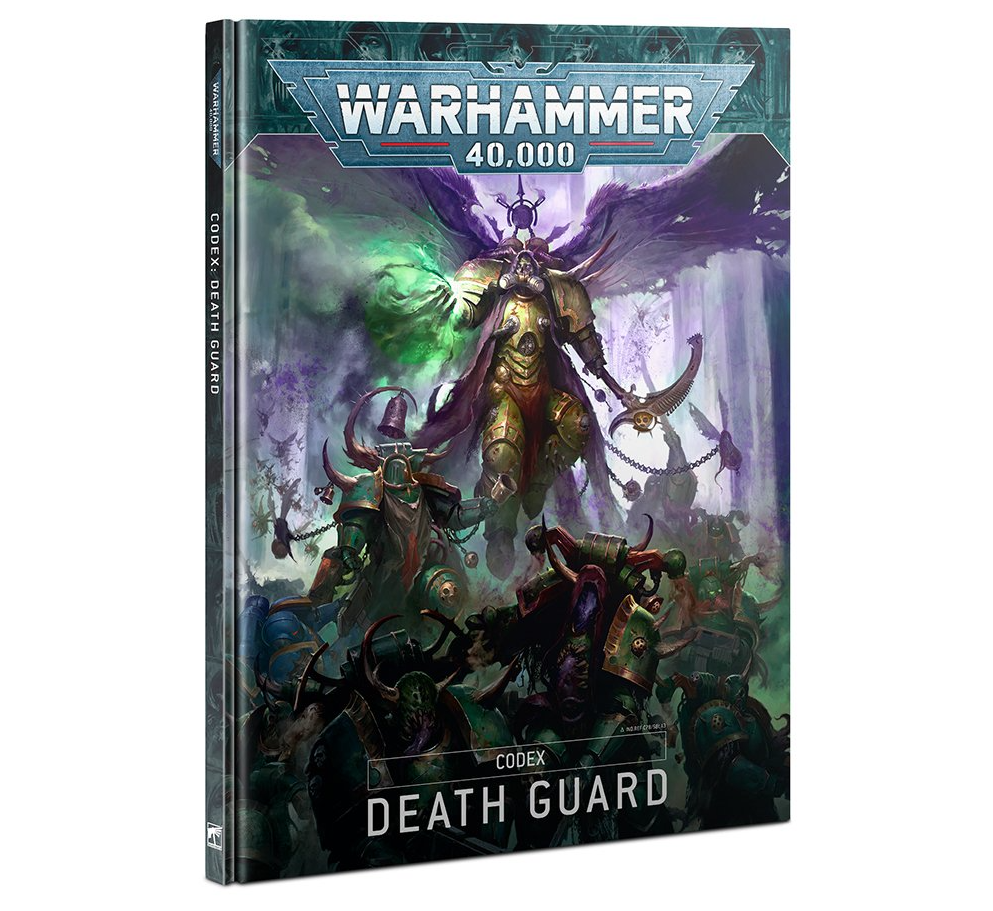The armies and factions of Warhammer 40,000 are all brutal and impressive in their own ways. As new books release, we dive into the lore presented in each, and how it shapes the fictional universe we love and make war in. In today’s review, Raf Cordero is diving into the lore presented in the new 9th edition Codex: Death Guard and how it presents one of the game’s most disgusting factions.
Nurgle’s Chosen
The Death Guard do not typically make themselves known by bolter and blade. In fact, by the time you see their glowing eyes it’s likely already too late. So strong is the miasma of pestilence that heralds Nurgle’s favored sons that there’s a good chance you’ve been reduced to a mass of rot and maggots by the time you’re aware an enemy is heading for you. The Death Guard march along with a bouquet of death; flies, maggots, and every disease vector you can imagine. The former Astartes themselves belch bile, slough their skin, and wield weapons that spread plague all thanks to the “blessing” of Grandfather Nurgle. They’re as dour as they are disgusting, and they’re heading for the heart of the Imperium.

Originally one of the Emperor’s most determined Legions, the Death Guard marched steadily through the galaxy in the name of the Great Crusade. They fought under the leadership of their Primarch Mortarion and were known for being stalwart and resolute. They never gave an inch, never faltered, and stood where even Astartes would fall to pollution and disease. When they turned, they retained those traits and pointed their ships to Terra with the same determination. Unfortunately, they were to be betrayed.
Mortarion’s First Captain Typhon had already fallen to Nurgle when the Death Guard ships prepared to assault Terra. Just prior to their transition to Warp Space he had all of the Legion’s astropaths killed and led the ships themselves. Once in the Warp they found their ships stilled and beset by the Destroyer Plague. Even their enhanced constitution was no match for this, the most deadly and painful of Nurgle’s plagues. Mortarion himself soon succumbed to the rot and in a fit of desperation he swore his soul and the soul of all his soldiers to Nurgle, if he would just end the pain and misery.
Nurgle heard Mortarion’s cries. The pain subsided, though the disease did not. The Legion found itself best by all manner of rotting mutations. Covered in sores, dripping in pus, and wielding rotten rusted blades they quickly resumed their quest and have fought for Chaos ever since.
Mortarion
The Demon Primarch Mortarion flies over the battlefield on massive moth-like daemon wings. Like his sons he spreads disease simply through his presence on the battlefield; lesser enemies will succumb to plague before getting close enough to scratch his armor (not that they could). He is clad in Barbarus Plate he made himself, and wields a scythe and plasma pistol with deadly ease. Fully sworn to Nurgle, Mortarion has been reborn as a demon prince. He was not always this way, however.

Mortarion was raised on the planet Barbarus by a brutal alien overlord. Housed in a keep in the highest levels of a poisonous and polluted atmosphere he was taught to wage war and let loose on the weak humans of Barbarus. He eventually came to learn that they were members of his own species and he turned on his “father”, leading a revolution. Fighting at the front of his army they tore down the alien bastions…all but one. When it came time to destroy his adopted father, he found that this final bastion was built too high in the clouds. Even Mortarion could not survive these heights. As he lay gasping, the Emperor of Mankind arrived. It was the Emperor who slew Mortarion’s father; ending the revolution but denying Mortarion revenge.
This theft of revenge planted the seeds of bitterness deep in Mortarion’s hearts; this seed would eventually blossom in Nurgle’s garden. Now Mortarion rules over a plague planet. His forces are now the ones living in lofty strongholds high in the clouds of corruption. He has become a cruel mirror of his own adopted father, his disease laying waste to the lower regions of his planet just like the pollution of Barbarus. For some reason, that bitterness has never subsided.
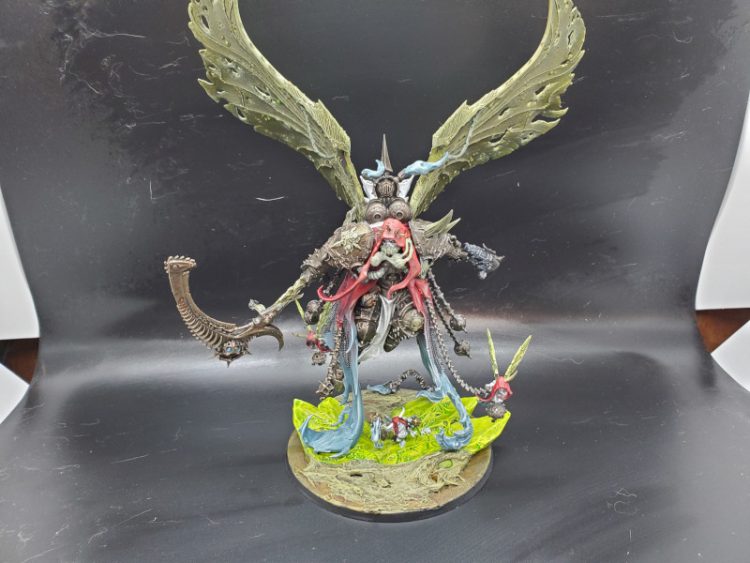
Typhus
Perhaps the real father of the Death Guard, Typhus’ (then Typhon) is the one that brought the Death Guard to chaos. Like his father, Typhon harbored a deep bitterness. Mortarion eschewed pskers and magic, casting it out of his legion. Typhon harbored secret psyker powers and found comfort in the whispers of Nurgle and Grandfather’s emissaries. When Typhon himself fell to the Destroyer Plague, he did not simply embrace it; he became it. It entered his body wholly, fusing his armor shut and swelling his stature.
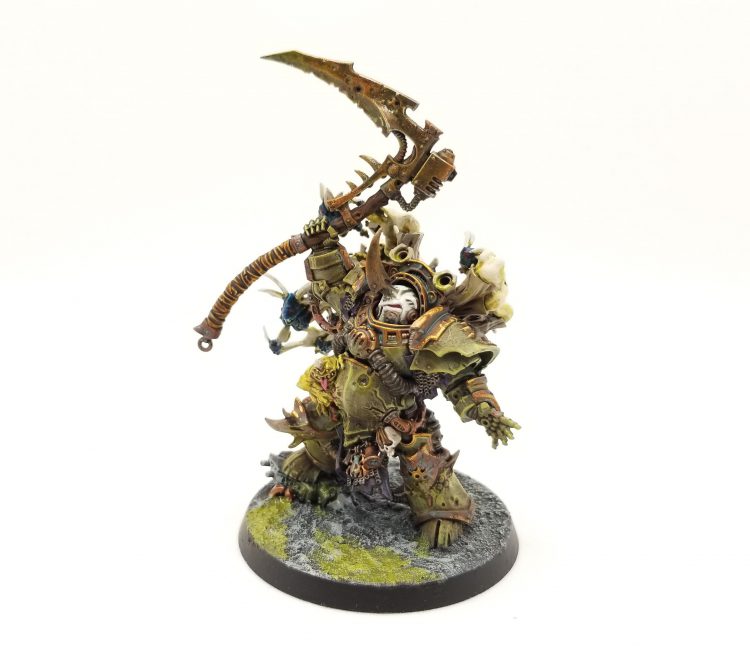
Typhus rejected Mortarion’s plan to hide in the Eye of Terror and build a stronghold. Instead he set out on his own crusade, bringing countless planets and billions of souls the Destroyer Plague (among many others). He is also responsible for spreading reanimating plagues; the Poxwalker hordes currently vexing the imperium are often seen in Typhus’ wake. Unlike most Legion First Captains, Typhus seems to have visceral disdain for his Primarch and they have become rivals in the quest for Nurgle’s power. They may still work together on occasion when the needs of Nurgle demand it, however – see Plague War buy Guy Haley for a clear recent example of this.
Warbands of Note
Codex: Death Guard includes some information on two named Warbands from the legion’s Plague Companies. Ostensibly they’re here to inspire some armies and provide a glance into some of the specific companies, but there are also some tidbits of interest to the greater universe.
The Venomariners are a marauding band or ravagers who ply space in a ship-based fleet. Skilled in ship to ship combat, they also excel at infantry-based boarding raids and relish hand to hand combat. They contain multitudes, is what I’m saying. These raiding tactics also work for planet assaults. The Venomariners are known for raiding a planet before quickly departing, leaving behind Miasmic Malignifiers (new model alert!) to corrupt the planet. By the time the residents of the planet rebuild it’s too late to survive the plauges.
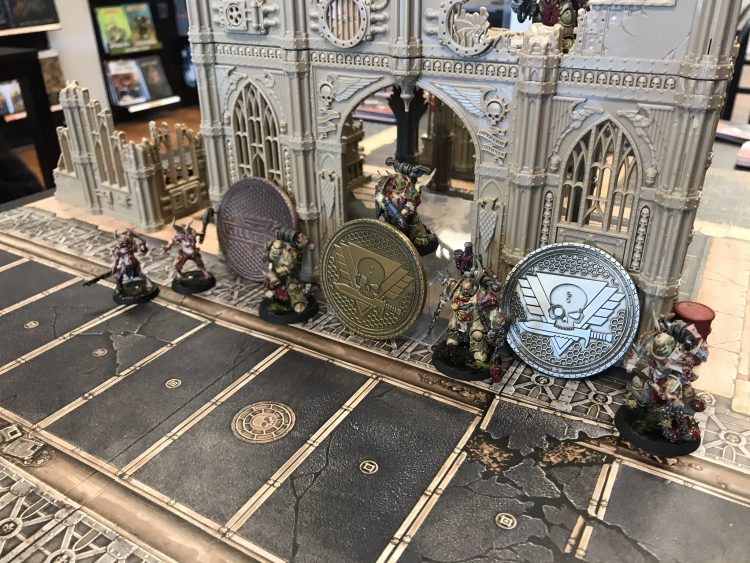
One of the Venomariners’ primary theatres of war is a multiyear campaign against Hive Fleet Scitalis. The Tyranids have begun an assault on a Nurgle stronghold and the Venomariners are the primary defenders. While the Tyrnaids have proven resistent to disease—and are capable of evolving around it—it has also presented a great opportunity for the diseased warriors. By liquefying the corpses of dead Tyranids and including them in their work, they have crafted entirely new xenos-infused diseases. Skurvithrax is not interested in sharing, so we’ll see what this means going forward.
The Weeping Legion is another warband whose description is stomach-turning. They constantly ooze a bloody puss that dries on their armor, making them more resistant to damage. They daub this mixture on their daemon engines, in turn making those engines stronger as well. This Sanguous Flux is deadly to humans and, notably, Orks as well. In the Panfor Cluster the Weeping Legion used this flux to great effect, weakening humans and greenskin alike before entering to deal with weakened forces. Their victory was stymied, however, by the emergence of a Necron Pariah Nexus. Interestingly, the warp-stilling effect of the Nexus is also making the Death Guard contagions weaker and less effective.
Wrap Up
As expected, Codex: Death Guard is gross. There seem to be seven times seven times seven synonyms for pus, bile, and blood and the writing team has deployed as many of them as possible across these pages. If you have the stomach for it, the lore section is a fun read. It also includes a breakdown of how the forces are organized and a nice little 2-page short story that serves to sell the new terrain models but also serves up an interesting cliff hanger. In keeping with the 9th edition trend, there’s less here fluff-wise than in previous books, but the Codex gives a decent overview of the structure of the Death Guard and its formation.
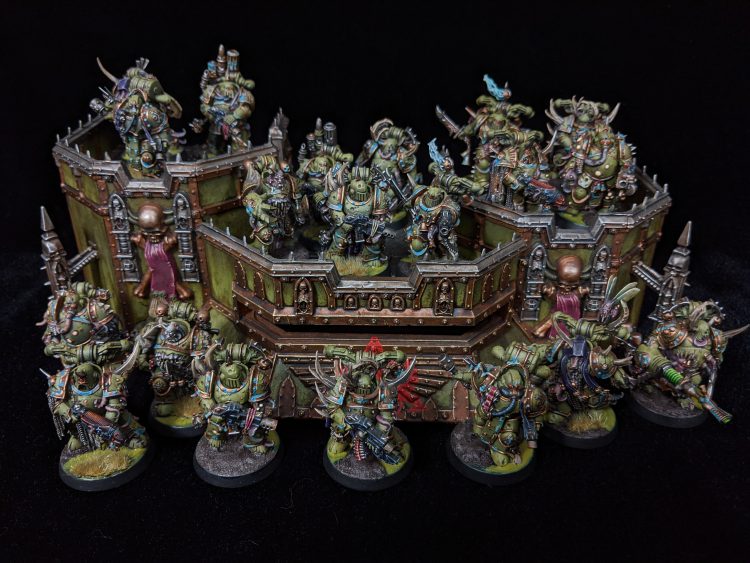
The Death Guard fight together but they aren’t, together. While they’re tighter knit than many Chaos Legions they are still riven through with infighting and rivalry (no doubt influenced by Typhus and Mortarion). While I don’t feel any sympathy for these putrid fighters, they are a little sympathetic. They didn’t embrace Chaos so much as were tortured into submission and now they’re stuck living that eternal “kid in daycare” petri dish life. For those of you picking up a new army, there’s good stuff in here to inspire your next painting project and it can help you break out of the standard Death Guard Green if you’re so inclined.
Have any questions or feedback? Drop us a note in the comments below or email us at contact@goonhammer.com.
